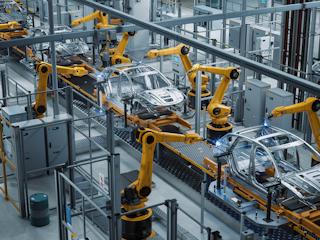With digital transformation constantly reshaping the manufacturing sector, the ability to adapt is vital for long-term success. However, sustaining a competitive edge requires more than just keeping pace with market changes — it demands continuous improvement across every facet of the organization.
What does success look like?
Broadly speaking, there are three main success factors that should drive your manufacturing commerce acceleration initiatives. These are customer experience, business adaptability and the integration of technology.
Customer experience is the primary success factor, because it depends heavily on the others. Moreover, a better customer experience translates directly and indirectly into higher profit margins, while business agility and technological innovation reduce operational costs and improve efficiency.
Any enterprise ultimately measures success by its financial health and growth trajectory, but it’s how you reach these top-level goals that really matters. Establishing key performance indicators (KPIs) for each role, department and project to track the impact of your projects across every key area can be a huge help to get there.
There’s much more to measuring success than simply tracking numbers that look good. For example, vanity metrics like website visitor counts or number of social media followers are nice to boast about but mean little in isolation. Similarly, revenue growth metrics alone don’t provide the actionable insights you need to identify precisely what’s working well and which areas need some improvement.
Customer-centric metrics include KPIs like customer lifetime value (CLTV), delivery rates and customer retention rates. These are vital to sales and service teams. For maximum relevance and targeted insights, it’s best to distil these metrics down into different customer segments. For instance, you might track them by region, target industry, business size or sales channel.
When it comes to measuring business agility, you’ll be looking at broader market trends and changing industry standards and expectations. One important agility-related KPI is time to market (TTM). A shorter TTM indicates an ability to quickly adapt to new market conditions. Other key metrics include product development cycle times, supply chain agility and rate of innovation.
Finally, we have metrics that define the success of your technology deployments, such as ecommerce portals and eLearning platforms. These are primarily relevant to the IT department, whose responsibility it is to maintain your systems in pursuit of better customer experiences and enhanced business agility. Important KPIs include mean time to resolution (MTTR) when problems arise, service availability and uptime, and application programming interface (API) utilization rates.
By measuring metrics across these three domains and relating them back to one another, you can gain a clear understanding of critical factors like improvements in efficiency, cost control and productivity.
Everything starts with company culture
In recent years, many enterprises have fallen into the trap of operating as though they’re still in survival mode. The manufacturing sector is no exception. Many executives remain focused on reducing costs, whether that means turning to automation to reduce headcounts or holding back from innovative new projects. Either approach is primarily a survival tactic that does little to drive long-term growth.
We’re now on the cusp of the fifth industrial revolution, or industry 5.0. Whereas industry 4.0 focused on the integration of data and automation technology, the current industrial revolution is people-centric. It’s about people and machines working together to create more sustainable products.
Of course, automation, artificial intelligence and the internet of things (IoT) will all continue to play a central role, but the focus is shifting towards how companies can drive better employee and customer experiences and keep up with sustainability demands.
Since we’re talking about people, we’re talking about culture. And that culture needs to span the entire business, from workers on the shop floor to sales representatives in the back office and, ultimately, customers themselves.
To stay relevant and profitable, manufacturers need to encourage experimentation and drive innovation. You also need to bring outside perspectives into product development and sales development to ensure your internal processes are as closely aligned with customer expectations as possible.
To make this happen, manufacturing executives must foster a culture of continuous learning and professional development. This is vital for keeping employees engaged. After all, happier employees typically mean happier customers, too.
However, there’s also a more practical side to the coin. New and emerging technologies like digital twins and artificial intelligence also demand new skill sets and areas of expertise. That’s why building up the required digital skills is crucial for driving cultural change.
Finally, it’s important to prioritize continuous improvement and innovation. It’s not about adopting new technology as quickly as possible just because it’s new. Doing so will only overburden your team and stretch your budgets while adding risk.
Instead, focus on smaller and more attainable goals first. For example, instead of trying to automate 100% of your orders from the outset, aim for around 50 or 60%, then make incremental improvements from there.
Preparing for the future
Manufacturers face challenging times. But periods of crisis are also catalysts for innovation, and technology has reached the point where it can unlock many new opportunities. Commerce is among the most promising growth areas. It’s more feasible than ever for manufacturers to expand their commerce initiatives, both across traditional channels like large accounts, distribution, resellers and newer ones like D2C.
Are you ready to take the next leap in B2B manufacturing? Download Valtech’s latest report to explore actionable strategies and expert insights from four of Europe’s industry leaders.











